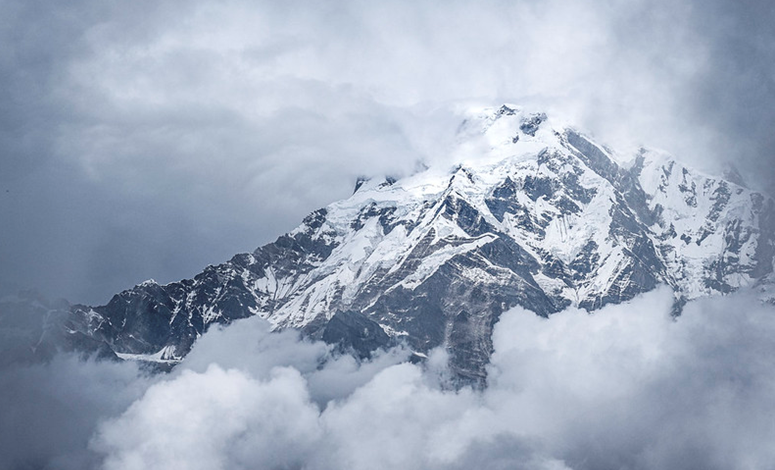
Only over a short period of time after the trekking route was open for travelers, the Mardi Himal Trek gained immense popularity instantly. Today, it has not only become a destination for travelers seeking adventure but also captures and brings people who are immersed in the culture, rich biodiversity, flora, fauna, and bird watchers from all around the globe.
For those unaware, the Mardi Himal trek lies in the Annapurna region, the northwestern part of Nepal. Due to its least-explored places, rugged terrains, and unspoiled natural beauty, it is also known as the “hidden gem of Nepal.”
In the meantime, the Mardi Himal Trek is also known as the “Another Sanctuary Trek,” and every traveler and trekker shares an intimate experience with the greenery and rich biodiversity of this region. As this trek starts and ends in Pokhara, it winds through lush rhododendron forests, alpine meadows, and rugged mountain terrain.
As the journey portrays a backdrop of the local villages and majestic mountains, you will also get a chance to encounter birdlife and other wildlife.
Contents
Bird Watching On Mardi Himal Trek
One of the major highlights of the Mardi Himal Trek is the diverse variety of birds that you will get to observe in their natural habitat. Yes, this particular trek is indeed an ornithological paradise.
As you trek on this trail, you will be greeted by the Himalayan Monal, aka Danphe (Nepal’s national bird). The deeper you trek into this region, the more birds you will get to observe. From various species of pheasants to vultures, you will see it all!
During this journey, you will be captivated by the beauty and calls from birds such as laughing thrushes, bulbul, finches, and so on. At the same time, you should not miss out on the sights of the woodpeckers, pheasants, and many more.
Some of the other significant birds in the area are listed below.
- Stripe Throated Yuniha (Nepali Name: Thupalkalki Jurechara)
- Mountain Hawk Eagle (Nepali Name: Pahadi Shadaha Cheel)
- Yellow-billed Blue Magpie (Nepali Name: Sunthunde Lampucchre)
- Darjeeling Woodpecker (Nepali Name: Darjeeling Kasthakoot)
- Scaly-bellied Woodpecker (Nepali Name: Tulokatle Kaathfor)
- Crimson Horned Pheasant (Nepali Name: Satyr Tragopan)
- Magpie (Nepali Name: Dhobini Chari)
- Yellow-billed Cough (Nepali Name: Temu)
- Cuckoo
- Snow Partridge
- Blood Pheasant
- Himalayan Vulture
- Warblers
- TIts
- Finches
- Minivets
A fun fact! Mardi Himal is located next to the Piper Area, which is a sanctuary for pheasants. According to the World Pheasant Association (WPA), this area has recorded the sightings of the most number of pheasants.
Best Season For Bird Watching In Mardi Himal
Meanwhile, spring (March, April, and May) and autumn (September, October, and November) are the best seasons for birdwatching due to the clear skies and weather. However, it also heavily depends on the species of the bird.
Among the diverse range of birds that are found and seen in the Mardi Himal trekking route, some species, such as cuckoos and minivets, are more active during the Monsoon / Summer season (June, July, and August). Yes, the heavy rainfall and slippery trails make this trek more challenging during this season; however, it provides a different perspective on these species.
Similarly, various species of finches are widely active during the harsh temperatures of the Winter season (December, January, and February). Therefore, if you have a specific species in mind, the Mardi Himal trek offers a bird-watching journey all year long.
On the other hand, the dry seasons are the best for bird watching, as they provide optimal visibility for spotting birds. Not to mention, the weather during these seasons is of moderate temperature.
Necessary Equipment For Bird Watching
If you are embarking on the bird-watching journey, below are some of the tools to make your trip successful.
- Binoculars: It helps you to observe the birds up close without disturbing them. If you are looking to buy a pair, it is always advisable to buy one with a magnification of 7x to 10x and a large objective lens (at least 42 mm), which are not only water-proof but fog-proof as well.
- Camera and Lenses: Alongside the bird-watching experience, you should have a good camera and lenses if you wish to capture your journey. Generally, we advise you to use a digital SLR or mirrorless camera with a telephoto lens (300 mm or longer). Additionally, you should also use a tripod for stability.
Tips For Identifying Birds
- You can always carry a guide with you for the bird-watching journey. It will help you to spot the different species. Well, you can ask for field guides who are well-versed in the detailed descriptions of bird species, including their habitat, behavior, and calls.
- Another great tip is to familiarize yourself with the calls of different species. Often, it helps when the birds are seen hidden among the foliage.
- Patience is the key during bird-watching! At times, you might have to wait for a longer period of time to get a glimpse of a bird simply.
Beyond Bird Species: Flora And Fauna Of The Region
The Mardi Himal trek offers more than just the bird species. This particular trail is rich in various flora and fauna species alongside the rich cultural and traditional background.
Although the Mardi Himal Trek is relatively short, it takes you through a varied ecosystem, from lush greenery to high-altitude terrain. One of the primary highlights of this trek is the blossoming Rhododendron forests along the trail.
As you take on this journey, you will get to see Rhododendrons, aka Laliguras (National Flower of Nepal), in various colors such as red, pink, and white. If you are trekking this trail during the spring season, you will also come across various blooms, such as magnolias, primroses, and orchids.
On a similar note, you will also trek through the dense forests of oak, maple, and bamboo. Not to mention, as you come across the settlement areas, you will also pass through agricultural farms and terraced lands. During summer, you will be able to see a meadow filled with wildflowers.
Now, moving on to the wildlife, there are several presence of multiple species. In the lower section of the trek it is home to langur monkeys, Himalayan pheasants, and colorful butterflies such as the Common Jezebel and Red Lacewing.
As you ascend higher, you will get a chance to see Himalayan Thar, wild goat, spotted deer, barking deer, and musk deer. Hare, if you are lucky enough, you might get a glimpse of the snow leopards of the area.
Apart from these gigantic animals, you will see amphibians, such as the elusive snow frog and the Himalayan salamander. Additionally, it also includes insects such as various species of butterflies, moths, beetles, grasshoppers, and crickets.
Read Also: The best credit card in Canada
People And The Views From Mardi Himal
While you will be able to immerse yourself in various cultures and traditions during your Mardi Himal trek, the region is mainly inhabited by Gurung, Magar, and Tamang. The locals are super friendly, and you will get a chance to experience festivals such as Dashain, Tihar, and Lhosar up close.
Alongside the rich cultural background of the region, the Mardi Himal trek offers magnificent views of some of the most incredible peaks around the world. As a matter of fact, the whole journey comes to life during the sunrise and sunset hours when the rays directly strike these gigantic peaks. Below is the list of mountains that you can witness during this trek.
- Dhaulagiri I (8,163 meters)
- Annapurna I (8,091 meters)
- Annapurna II (7,937 meters)
- Annapurna III (7,855 meters)
- Varaha Shikhar (7,847 meters)
- Annapurna South (7,819 meters)
- Dhaulagiri II (7,751 meters)
- Annapurna IV (7,525 meters)
- Gangapurna (7,483 meters)
- Machhapuchhre (6,991meters)
- Nilgiri (6,940 meters)
- Lamjung Himal (6,931 meters)
- Tukche Peak (6,920 meters)
- Himchuli (6,441 meters)
- Thapa Peak (6,015 meters)
- Mardi Himal (5,588 meters)
- Singu Chuli (6,500 meters)
- Tharpu Chuli (5,663 meters)
What To Pack For Mardi Himal Trek?
- Inners
- Trekking t-shirt
- Trousers
- Waterproof backpack
- Waterproof hiking boots
- Sunglasses
- Sun hat
- Sunscreen
- Lip balm
- Moisturizer
- Adjustable and shock-absorbent trekking poles
- Lightweight socks
- Sleeping back
- Rain cover
- Phone with SIM card or satellite phone
- Water bottle
- First aid kit
- Medicines (if you take any)
- Toiletries such as wet wipes, soap bars, and towels
- Camera
- Torchlight with extra batteries
- Adapters and power cables
In A Nutshell
The Mardi Himal is not only a trekking route or a destination for cultural immersion. It has tons to offer. It is home to a number of bird species and unique flora and fauna that are native to this region. Whether you are an avid birder, a thrill seeker, or a nature enthusiast, this place has all the right deals.



